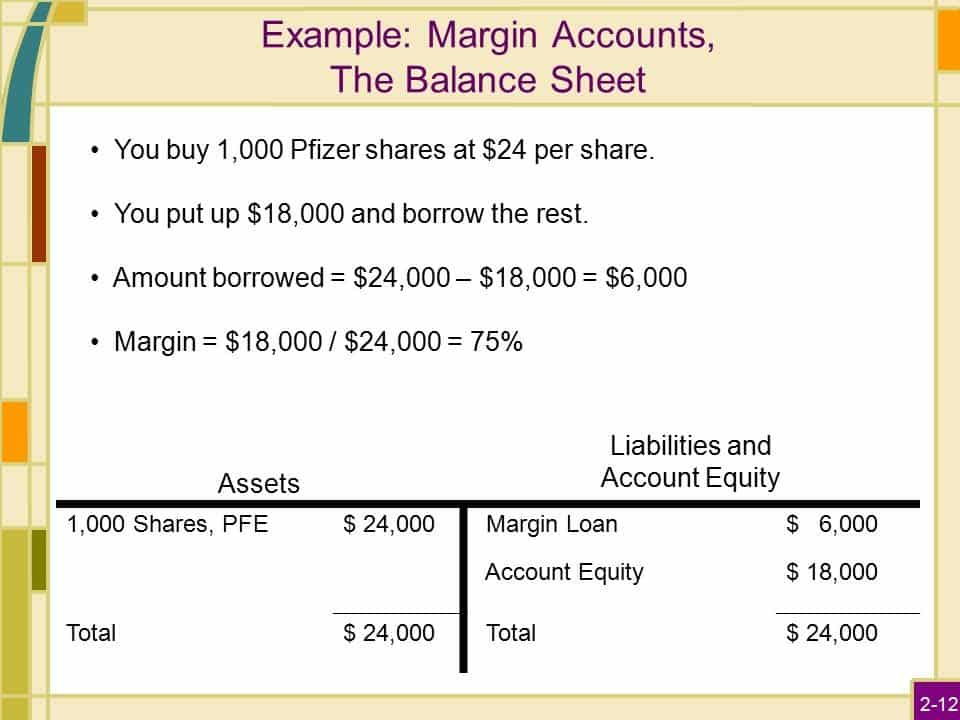Welcome to the financial crossroads where savvy investors make critical decisions – the choice between a Margin Account and a Cash Account. Navigating the world of investing requires not just market insights but also a keen understanding of the tools at your disposal. In this guide, we’ll unravel the complexities of Margin Accounts and Cash Accounts, helping you make informed choices that align with your investment goals.
Picture this as your gateway to a financial landscape where each account type plays a distinct role in shaping your investment strategy. Whether you’re a seasoned investor or just stepping into the realm of stocks and securities, knowing the nuances between Margin and Cash Accounts is paramount. So, buckle up as we explore the features, risks, and rewards of each, empowering you to make decisions that resonate with your unique financial aspirations. Welcome to the beginning of your journey into the intricacies of Margin Accounts and Cash Accounts – the backbone of intelligent investing.
What Is A Margin Account?
A Margin Account is a financial arrangement that allows investors to borrow funds from a brokerage firm to purchase securities, such as stocks or bonds. Unlike a Cash Account where transactions are conducted with the investor’s own funds, a Margin Account enables traders to leverage their investments by borrowing money, essentially magnifying their buying power.
In a Margin Account, the investor is required to maintain a certain level of equity, known as the margin requirement, which is a percentage of the total value of the securities held in the account. This margin acts as a security against potential losses incurred in the market.
One of the key features of a Margin Account is the ability to trade on margin, allowing investors to buy more shares than their cash balance would typically allow. While this leverage can amplify profits, it also introduces additional risks, as losses are also magnified. The margin account, therefore, demands a careful balance between risk and reward, making it a tool suited for experienced and risk-aware investors.
In summary, a Margin Account offers investors the flexibility to borrow funds for trading, potentially enhancing returns but requiring a heightened awareness of market fluctuations and risk management.
How To Calculate Margin Requirements?
Per TD Bank, to calculate the margin required for a long stock purchase, multiply the number of shares X the price X the margin rate. The margin requirement for a short sale is the regular margin requirement plus 100% of the value of the security.
Margin Requirement = shares x price x margin rate percentage
What Is A Long Margin Stock?
Purchase 1,000 shares of a stock at $50 with a margin rate of 30%. The margin requirement would be:
1,000 shares x $50 x 30% margin rate = $15,000
This is the minimum required amount of cash or excess margin that must be in the account before a buy order can be entered.
Since 30% is the margin rate, TD Direct Investing is lending the account holder 70% of the trade value.
Maximum loan value is 1,000 shares x $50 x 70% = $35,000

What Is A Short Margin Stock
Short sell 500 shares of a 50% marginal stock priced at $10.00. The margin requirement is 150%. Note: 100% of the margin requirement is generated from the sale of the security. Therefore, the additional initial margin requirement is 50%, the same amount required in order to accept the trade if you were purchasing the stock.
500 shares x $10.00 x 50% = $2,500
The total margin requirement to hold the position, including the 100% of the proceeds from the short sell, is calculated as follows:
500 share x 10.00 x 150% = $7,500
Margin Account vs. Cash Account
As per Investopedia, The main difference between a cash account and a margin account is that in a cash account all transactions must be made with available cash or long positions.
When buying securities in a cash account, the investor must deposit cash to settle the trade or sell an existing position on the same trading day, so cash proceeds are available to settle the ‘buy’ order.
A margin account allows an investor to borrow against the value of the assets in the account to purchase new positions or sell short. In this way, an investor can use margin to leverage his positions and profit in both bullish and bearish times in the market.
Margin can also be used to make cash withdrawals against the value of the account as a short-term loan.
Example For Margin Account
Let’s assume you have $5,000 and Company XYZ trades at $10 a share. In a regular brokerage account, you would only be able to purchase 500 shares. If XYZ were to appreciate by $10, you would make $5,000 and earn a respectable +200% gain.
But with a margin account, you could borrow money from the brokerage firm and collateralize the loan with the Company XYZ shares. Margin requirements for equities are normally 2 to 1 for the average investor, meaning you purchase double what your cash balance is.
With the $5,000 from the previous example, an investor with a margin account would be able to purchase $10,000 of Company XYZ or 1,000 shares. That same $10 price move would mean you now make $10,000 and earn a +300% return.
Pros Of Buying On A Margin Account
As per motley fool, the greatest advantage of buying on a margin account is that it boosts your purchasing power. When you have a relatively small amount of money to work with, margin can be used to boost your returns or help diversify your portfolio.
Imagine for a moment that you have $2,000 to invest and you really want to sink it into Apple stock. If you were in a cash account you could buy around eight shares.
However, depending on the level of margin that you qualify for (depends on the brokerage firm) and the margin requirements for each security (which is also set by the brokerage), you may qualify to buy anywhere from 12 to 24 shares of Apple in a margin account.
If Apple stock raises $5 in a cash account you’ll have made $40 (not including commission costs). However, in the margin account, a $5 increase in Apple would net a profit of anywhere from $60 to $120 before commissions.
This substantial leverage can be incredibly beneficial in a bull market, and it can be used to multiply your returns.
Another pro is that buying on a margin account gives you more investing options. With a cash account, you’re “stuck” buying stock or are confined to some very basic options strategies.
In an account with margin capabilities you can bet against stocks (short-selling) or you can dabble in all types of stock options strategies, which grant you the right to buy or sell 100 shares of an underlying stock at a predetermined price.
Both short-selling and options are inherently riskier than simply buying a stock and holding, but they offer additional ways for experienced investors to make money.
In a cash account, all transactions must be made with available cash or long positions. When buying securities in a cash account, the investor must deposit cash to settle the trade or sell an existing position on the same trading day, so cash proceeds are available to settle the “buy” order.
Cons Of Buying On A Margin Account
But, as you might imagine, buying on margin comes with risks.
The biggest risk you have when buying on a margin account is that you don’t know, with any certainty at least, that the stock you purchased or short-sold will do what you expect.
Even the best stock pickers in the world are wrong around a third of the time, which means there’s a lot of inherent risk in playing with margin.

For example, if the value of your investment(s) declines you may be required to deposit additional capital to cover your margin. In fact, it’s possible to lose more money than your initial investment when buying on the margin account.
Let’s remember that a margin account is nothing more than a loan you’ve accepted from your broker. If your account equity isn’t high enough to maintain your position, your broker will often allow a week to add additional funds to satisfy your “margin call” or “house call,” otherwise it will liquidate some, or all, of your position.
Ultimately, the broker needs to protect its loan, which means it will have no qualms about liquidating your position if you’re not in compliance.
Another oft-overlooked disadvantage of buying on a margin account is that you’ll owe interest on your loan. Just like with any bank, the higher the amount of the loan, or the more you trade, the lower your interest rate will be.
But, make no mistake about it; your margin rate will be substantially higher than the prime rate. Currently, most investors buying on margin will owe about 8% per year on the amount they borrow. If you don’t believe you’ll make at least 8% per year, then investing with margin may be a poor idea.
Although, one caveat worth noting here is that you may qualify for a tax break based on the amount of interest you pay from your margin usage.
This helps lessen the sting of your monthly interest payments (which are automatically collected by your brokerage firm) a bit, but it’s still a major risk to consider when buying on margin.
Conclusion
Ultimately that will come down to your risk tolerance and your knowledge of investing.
If you’re relatively green behind the ears, investing with margin may not be the best idea. The same goes for an investor who wants to avoid higher-risk situations such as short-selling and stock options.
However, if you’re a seasoned investor and you fully comprehend the risks involved and have intent on taking advantage of more complex options strategies, short-selling, and potentially even leveraging your buying power, then buying on a margin account could be a smart move.
If you found this article helpful, please share this post on social media and help spread the word. Also, do let me know your comments below.
Top 10 Popular Posts Of All Time
- Top 30 Canadian Blue Chip Stocks You Should Own
- How To Use A My Service Canada Account
- How To Watch Free TV Shows In Canada – List of 10 Best Sites
- 10 Costco Membership Benefits You Need To Know Today
- Top 7 Canadian ETFs You Should Own In 2020
- Retirement Benefits & Old Age Security Pension (OAS) In Canada
- 7 Quick Ways To Maximize Your PC Optimum Points
- WestJet Rewards Review – Everything You Need To Know
- How To Get An Emergency Canadian Passport – Complete Guide
- How To Open A CRA My Account In 2020?
